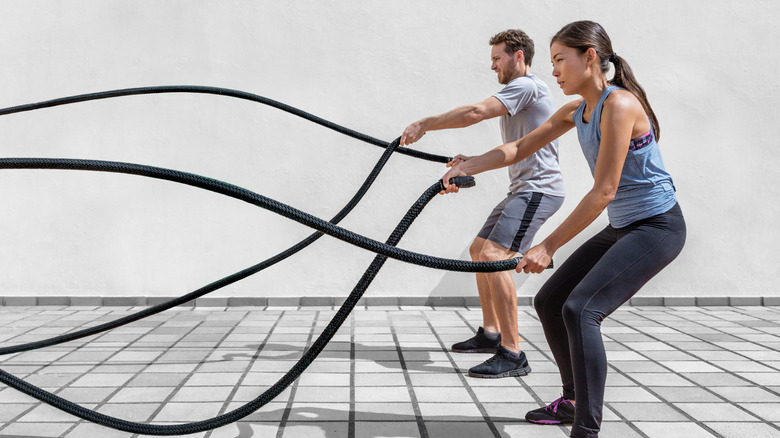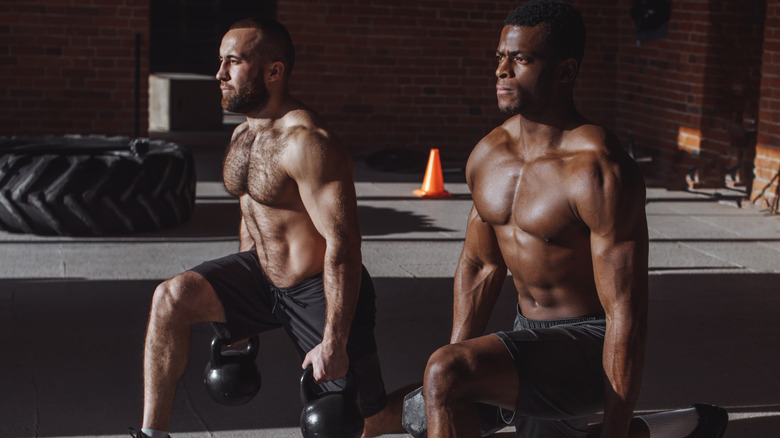How To Avoid These Common CrossFit Mistakes
In more than 15,000 gyms worldwide, CrossFit is a great way to meet new people, bust your heart rate to the max, and build self-confidence (via Livestrong). CrossFit still maintains its stronghold in the fitness community, adding more than 1,400 CrossFit boxes in 2021 despite the pandemic (per Morning Chalk Up).
According to Men's Health, a typical Crossfit class begins with some functional movements to get the muscles and joints warm. You'll then move to strength or skill-improvement exercises, such as pistol squats or deadlifts. The workout of the day — or WOD — comes next, which is a routine involving specific repetitions and exercises. Some WODs will fit as many rounds as possible into a set time. For example, the Cindy requires five pull-ups, 10 pushups, and 15 squats for as many rounds until 20 minutes are up. Other workouts will have you busting out a certain number of rounds of exercises as fast as possible. CrossFit also has "every minute on the minute" workouts, also called EMOM, that force a certain number of repetitions before the minute is up. If you finish before the minute is up, that's how much rest you get before the next minute (and set of reps) returns (via Byrdie).
When high intensity combines with time pressures, it's easy to make some mistakes as fatigue sets in. Here are the most common CrossFit mistakes and how to avoid them.
Mistake #1: Skimping on form
When you're in a rush, your hastiness often results in making mistakes. In Crossfit, this often means mistakes in form. According to Shape, beginners often make mistakes in the air squat and the deadlift. With the air squat, your toes should be pointed outwards, and your weight should be in your heels. As you drive through your heels, you should feel it in your glutes. With the deadlift, your overhand grip on the barbell should be outside your shins. Your back should be neutral, without excess curvature. When you lift, press your heels into the floor to raise your shoulders and hips at the same time, then keep the barbell near the body as the knees move back and chest lifts (via CrossFit Games).
If you are new to CrossFit or you're not quite sure how to perform each move, it's always best to ask an instructor (via The Box). That way, you're not ingraining bad habits as you make progress in your fitness. In fact, you're less likely to be injured in CrossFit if you work with a trainer, according to a 2014 article in the Orthopaedic Journal of Sports Medicine.
Mistake #2: Starting too fast
Although CrossFit workouts are relatively short, they aren't easy. Even if you're a seasoned runner who can bust a 5K in less than 20 minutes, you'll need to gauge your pace in CrossFit as well (per Shape). You might feel a huge burst of energy and feel great after the first few minutes of a 20-minute Cindy, but your body will feel heavier and heavier during those pull-ups if you don't pace yourself.
Even if you're overly eager to get a rock-hard CrossFit body, digging deep into your first few weeks without a solid foundation can easily lead to injury, according to The Box. Instead, be patient with yourself and learn the fundamentals before you add more plates to your deadlifts. Focusing too much on getting to the CrossFit games can easily tank your progress in your current workout (via Men's Health). It's better to take it slow and easy the first few weeks as your body acclimates to the workouts. Similarly, be sure to scale your workouts to your level of fitness, according to Livestrong.
Mistake #3: Being overly competitive
Let's face it; CrossFit fitness classes can be quite competitive. According to a 2014 study in the Journal of Strength and Conditioning Research, CrossFitters begin their memberships by trying to perform as well as they can. As they progress, they become more motivated by how others perform compared to them. Males, on the whole, tend to be more motivated by beating others, whereas females are more concerned about messing up their movements.
Seeing those results on your box's leaderboard can feel intimidating, or they can drive you to work harder. Keep your competitiveness in check by choosing a result that's doable for you, not the guy who's been a CrossFitter for 15 years (via Shape). Remember, he started somewhere, too. According to The Box, we all have strengths and weaknesses, and our performance can change from day to day. Exercising with ego can easily lead to burnout or injury. Instead, leave your ego at the door and give it your best each day without concern about beating others.
Mistake #4: Inconsistency in your workouts
CrossFit's popularity is rooted in its building community to help keep you motivated, according to The Box. However, you can't reap the community-building benefits if you don't make CrossFit part of your routine. If you consistently show up at your box at the same time, you know someone's going to be there to help push you when you want to give in. Shape suggests finding a partner or a mentor to keep you motivated.
Staying consistent with your CrossFit workouts can also reduce your risk for injury. In a 2018 study in the Orthopaedic Journal of Sports Medicine that surveyed more than 3,000 CrossFitters, 30.5% of them experienced an injury that year. However, those who worked out less than three days per week were more likely to experience an injury than those who were dedicated to their CrossFit training. If you're skipping that day's WOD because you absolutely hate overhead squats, you're missing out on CrossFit's purpose of improving all-around strength, according to BoxRox.
Mistake #5: Not taking a rest day
Even though you should remain consistent in your CrossFit training schedule, it's also important to know when to take the day off. When CrossFit began, athletes would train hard for three days and take the fourth day off. However, this rigid schedule might not be appropriate for your body, according to CrossFit. If you find your training consistently tanking or you're tired most of the time, it might mean that you need a recovery day. Sometimes training too hard or too often can lead to overtraining, which could result in serious injury, according to Livestrong. Not every workout will have you beating your benchmark, so giving yourself a little bit of recovery might have you coming back stronger. Remember to keep your ego in check.
If CrossFit is new to you or you're coming back from an injury, your body might need a little more time to adjust to workouts, according to The Box. If a day without a workout is challenging for you, opt for a swim or an easy walk.






